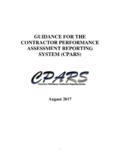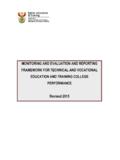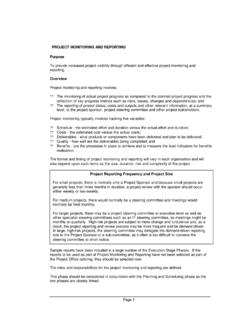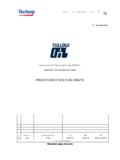Transcription of Texas Performance Standards Project …
1 $ SOCIAL STUDIESWE ARE TEXANS GRADE 44 Texas Performance Standards ProjectINTERMEDIATE TASKS We Are Texans (Grade 4) Texas Performance Standards Project 2008 Texas Education Agency 1 This guide links the We Are Texans unit to the Texas Essential Knowledge and Skills (TEKS) for fourth graders. We Are Texans is a social studies unit that allows students to study the differences between their own communities and other communities, researching what it would be like to live in other places. Though a social studies unit, We Are Texans also gives students opportunities to practice skills in the other subject areas of English language arts, mathematics, and science. For example, students use data gathering and logic, which the Mathematics TEKS include; the idea of chronology, which the Science TEKS address; and writing and research skills, which are part of the English Language Arts and Reading TEKS.
2 The following document includes the applicable TEKS and the details of the We Are Texans unit. The asterisks indicate that those TEKS are testable on the State of Texas Assessments of Academic Readiness (STAAR). The final section of this document presents the applicable Texas College and Career Readiness Standards adopted by the Texas Higher Education Coordinating Board (THECB) on January 24, 2008. Description of Unit This Project generates a deeper understanding of population groups that have settled in Texas . Students can study immigrant groups of the past or contemporary immigrant groups. How did the geography of Texas affect the settlers decisions to move here? What did geography have to do with their choices once they arrived?
3 Students will understand how physical geography is vital to the decisions and choices people have made or will make. Additionally, students will learn concepts of cultural geography. What did population groups bring with them from their old homes? What contributions have they made to Texas ? This Project promotes understanding of others through the discovery of similarities and differences among population groups who come from various places around the globe to live in one place. Goals Students will meet these goals in their explorations: Demonstrate deep knowledge of regional, physical, cultural, and political geography HIGH SCHOOL/EXIT TASKST exas Performance Standards ProjectINTERMEDIATE TASKSWe Are Texans (Grade 4) Texas Performance Standards Project 2008 Texas Education Agency 2 Analyze how landforms contributed to settlement patterns in Texas Make generalizations about how culture is affected by its geography and immigration patterns Conduct research and draw conclusionsPhase I.
4 Learning Experiences beginning the Project , take a tour of a museum. You may wish to go to one in yourcommunity, get a trunk from the Institute of Texan Cultures, or take a virtual tour of an onlinemuseum. Introduce students to the idea that they will be developing a museum display consistingof 7-10 artifacts. Ask them to identify criteria for an effective may wish to use some internet resources to design and implement lessons that will helpstudents understand what it means to curate an class will brainstorm population groups that have moved to Texas from another country ( ,Vietnam, Germany, Mexico). As a group, students select an immigrant group to study. They willfill out Worldwide Investigation (Attachment #1). The purpose of the chart is to guide studentsthrough a comprehensive research process before identifying their own countries forindependent a teacher-directed activity, students will identify the city, county, state, country, continent,and hemispheres in which they live.
5 Use a globe, an atlas, and/or maps. Students will completethe first triangle in Where in the World? Chart # student, individually or in groups, will complete the second triangle in Chart #1 for theimmigrant country that the student or group is studying. Students may be unable to fill in all theblanks for some foreign each student will complete An Immigrant s Journal Entry # each of the charts (#2-8), the student will, through teacher-led instruction, locate theresources and complete the charts about Texas and the countries he/she has chosen to researching a particular aspect, he/she will then write a journal entry in which he/sheassumes the role of an immigrant to Texas in the past or resource that might help introduce the journal concept to students is Talbott, Hudson.
6 Safari Journal: The Adventures in Africa of Carey Monroe. New York: Silver Whistle, 2003. Here is a sample of websites that contain primary sources: HIGH SCHOOL/EXIT TASKST exas Performance Standards ProjectINTERMEDIATE TASKSWe Are Texans (Grade 4) Texas Performance Standards Project 2008 Texas Education Agency 3 A valuable resource for this unit is the Institute of Texan Cultures, which can be found online. You may find a site that contains many useful resources, including Oral Histories Online. A Speaker s Bureau and Tex-Kits, trunks that contain artifacts of Texas immigrants may also be available. Texas folklore resources include: Curry, Jane Louise. Hold Up the Sky: And Other Native American Tales from Texas and the Southern Plains.
7 New York: Margaret K. McElderry, 2003. dePaola, Tomie. Legend of the Bluebonnet: An Old Tale of Texas . New York: The Putnam Publishing Group, 1996. DeSpain, Pleasant, and Joe Shlichta. Thirty-three Multicultural Tales to Tell. Little Rock, AR: August House Publishers, 1993. Dobie, J. Frank. Legends of Texas . Gretna, LA: Pelican Publishing Company, 1995. Forest, Heather. Wonder Tales from Around the World. Little Rock, AR: August House Publishers, 1995. Holt, David, and Bill Mooney. Ready-to-Tell Tales: Sure-fire Stories from America s Favorite Storytellers. Little Rock, AR: August House Publishers, 1994. Kellogg, Steven. Pecos Bill. New York: HarperTrophy, 1992. Kettleman, Helen. Bubba the Cowboy Prince: A Fractured Texas Tale. New York: Scholastic, 1997.
8 Phase II. Independent Research a group to study. Each student selects a group that immigrated to Texas onwhich to conduct independent guiding questions. Once students have identified their groups, each studentshould think of three to five guiding questions to explore, such as: Why did this immigrant group leave its home country? In what part(s) of Texas did the immigrants settle? What was life like for them in the new country? What were similarities and differences in their old and new ways of life? What contributions did the group make to Texas ?While these examples are general, the student s questions should be specific to the chosen immigrant group. The questions should lead him/her to form individual research-based opinions.
9 The student should also develop a hypothesis or some possible answers to the questions. HIGH SCHOOL/EXIT TASKST exas Performance Standards ProjectINTERMEDIATE TASKST exas Performance Standards Project 2008 Texas Education Agency 4 a research proposal. Each student should carry out a scientific researchprocess: Identify the group he/she will research List the guiding questions to be explored List the resources needed to find answers to the questionsIn the process of writing the research proposal, the student may refine the guiding questions. the research. After the teacher has approved student proposals, eachstudent begins using the resources he/she has identified and others he/she mayencounter. During this stage, students will need to keep a log, note cards, and/orresource process sheets of all the sources they use and what they need from each productEach student will create a museum display illustrating the contributions of the group ofimmigrants to Texas .
10 The museum display should have at least ten items in it, including, but notlimited to, photographs, symbolic objects, audiotapes, videotapes, and documents. One helpfulresource may be Studentsshould use Attachment #2 Final Product: Museum student will assume the role of a docent who is explaining the display to a group of fourth graders who are visiting the museum. Students in the audience should have an opportunity to ask questions. cover research proposal, including guiding research log, notes, or resource process Product: Museum Display, including videotape or audiotape of the docent s talk, including the Q&A sessionAdditional ResourcesStudents are encouraged to work with their teachers and parents/guardians to conduct the research necessary to support and enhance each task, following local district guidelines.









